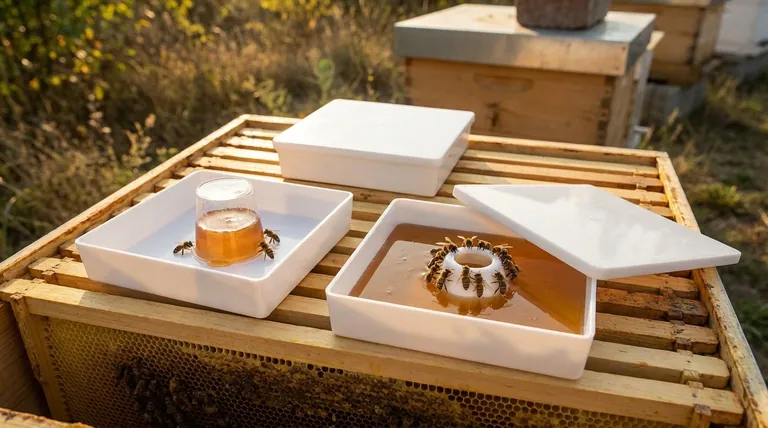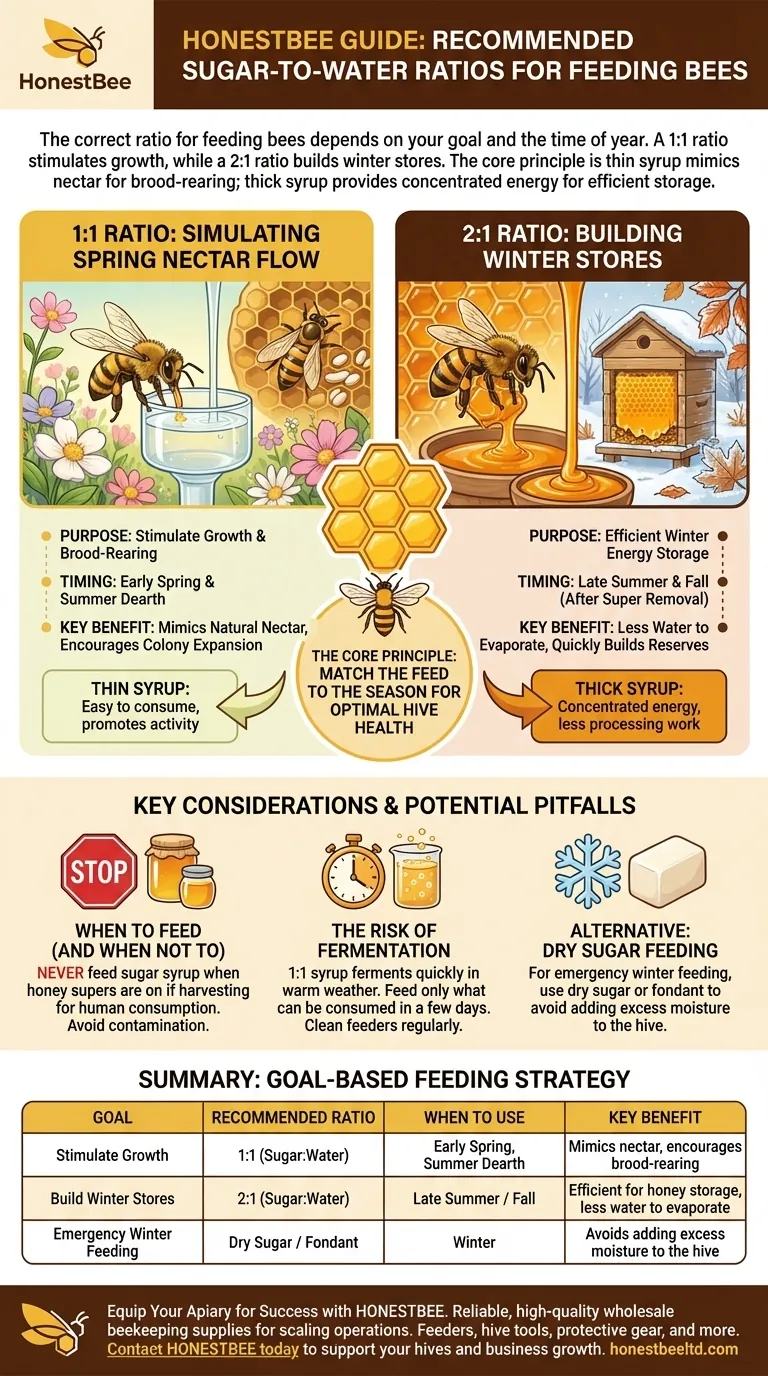The recommended sugar-to-water ratio for feeding bees depends entirely on your goal and the time of year. For general support and to stimulate colony growth, a 1:1 ratio (one part sugar to one part water by weight) is the standard. For helping bees build their winter food stores in the fall, a heavier 2:1 ratio (two parts sugar to one part water) is used.
The core principle is simple: a thin syrup (1:1) mimics natural nectar to encourage brood-rearing, while a thick syrup (2:1) provides a concentrated energy source that is easier for bees to store as honey for winter.

Why the Ratio Matters: Stimulation vs. Storage
Understanding the purpose behind each mixture is critical for maintaining a healthy hive. You are not just providing food; you are sending a specific signal to the colony.
The 1:1 Ratio: Simulating Spring Nectar Flow
A 1:1 syrup has a consistency similar to the light nectar bees would collect from flowers in the spring.
This thin mixture serves as a stimulant. It encourages the queen to begin laying more eggs and prompts the colony to expand its population and draw out new comb.
It is best used in early spring before the first major nectar flow or during a summer dearth when natural forage is scarce.
The 2:1 Ratio: Building Winter Stores
A 2:1 syrup is a much thicker, heavier feed. It does not mimic natural nectar and requires less work for the bees to process.
Bees must dehydrate nectar to turn it into honey, and this thick syrup has far less water to remove. This makes it an efficient way for them to quickly build up their honey reserves in preparation for winter.
This ratio should only be used in the fall, after you have removed any honey supers you intend to harvest.
Key Considerations and Potential Pitfalls
Feeding bees is a powerful tool, but it must be used correctly to avoid harming the colony.
When to Feed (and When Not To)
Feeding is a supplement for when natural resources are insufficient. Never feed sugar syrup when honey supers are on the hive if you intend to harvest that honey for human consumption.
Doing so can contaminate the natural honey with sugar water, and the resulting product cannot be considered pure honey.
The Risk of Fermentation
Sugar syrup, especially the thinner 1:1 mixture, can ferment quickly in warm weather. Fermented syrup can be harmful to bees.
Only provide an amount that the bees can consume within a few days, and be sure to keep your feeders clean between uses.
An Alternative: Dry Sugar Feeding
In the depths of winter, adding moisture to the hive can be detrimental. Some beekeepers prefer using a specially formulated dry sugar or fondant.
This method provides an emergency food source that bees can process without introducing the excess moisture that a liquid feed would.
Making the Right Choice for Your Goal
Select your feeding strategy based on the specific needs of your hive at that moment.
- If your primary focus is stimulating spring growth: Use a 1:1 sugar-to-water ratio to mimic a natural nectar flow.
- If your primary focus is helping the hive build winter stores: Use a heavy 2:1 sugar-to-water ratio in the fall for efficient energy storage.
- If your primary focus is emergency winter feeding: Consider using the dry sugar method to avoid adding excess moisture to the hive.
By matching the right feed to the right season, you provide your bees with the precise support they need to thrive.
Summary Table:
| Goal | Recommended Ratio | When to Use | Key Benefit |
|---|---|---|---|
| Stimulate Growth | 1:1 (Sugar:Water) | Early Spring, Summer Dearth | Mimics nectar, encourages brood-rearing |
| Build Winter Stores | 2:1 (Sugar:Water) | Late Summer / Fall | Efficient for honey storage, less water to evaporate |
| Emergency Winter Feeding | Dry Sugar / Fondant | Winter | Avoids adding excess moisture to the hive |
Equip Your Apiary for Success with HONESTBEE
Feeding your bees correctly is just one part of successful hive management. For commercial apiaries and distributors, having reliable, high-quality equipment is essential for scaling operations and ensuring bee health year-round.
HONESTBEE supplies the durable beekeeping supplies and equipment you need—from feeders and hive tools to protective gear and extraction systems—all available through our wholesale-focused operations. Let us help you build a stronger, more productive beekeeping business.
Contact HONESTBEE today to discuss your wholesale needs and discover how our products can support the health of your hives and the growth of your operation.
Visual Guide

Related Products
- HONESTBEE Professional Hive Top Bee Feeder Feeding Solution
- HONESTBEE Round Hive Top Bee Feeder for Syrup
- HONESTBEE Entrance Bee Feeder Professional Hive Nutrition Solution for Beekeeping
- HONESTBEE Professional Long Handled Hive Tool with Precision Cutting Blade
- Rapid Bee Feeder White Plastic 2L Round Top Feeder for 8 or 10-Frame Bee Hives
People Also Ask
- What should be done with feeders and equipment after feeding bees? Essential Steps for Apiary Health
- What is a top feeder for bees? Maximize Colony Health with Efficient Feeding
- What is the best way to top feed bees? A Safe, High-Volume Feeding Solution for Your Apiary
- How do I keep bees from drowning in my top feeder? Ensure Safe Feeding for Your Hive
- What safety features are included in top feeders? A Guide to Drowning Prevention and Hive Safety



















